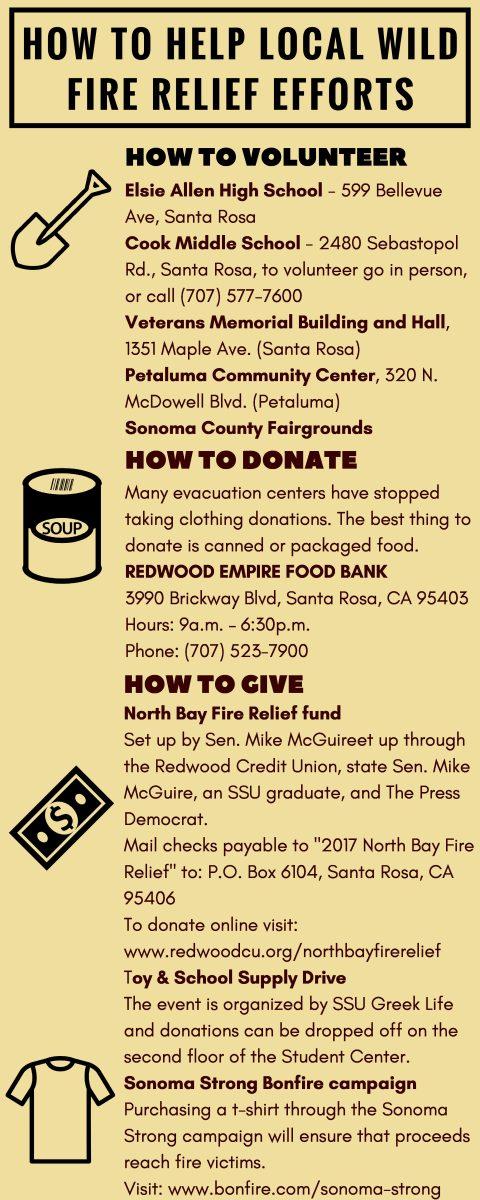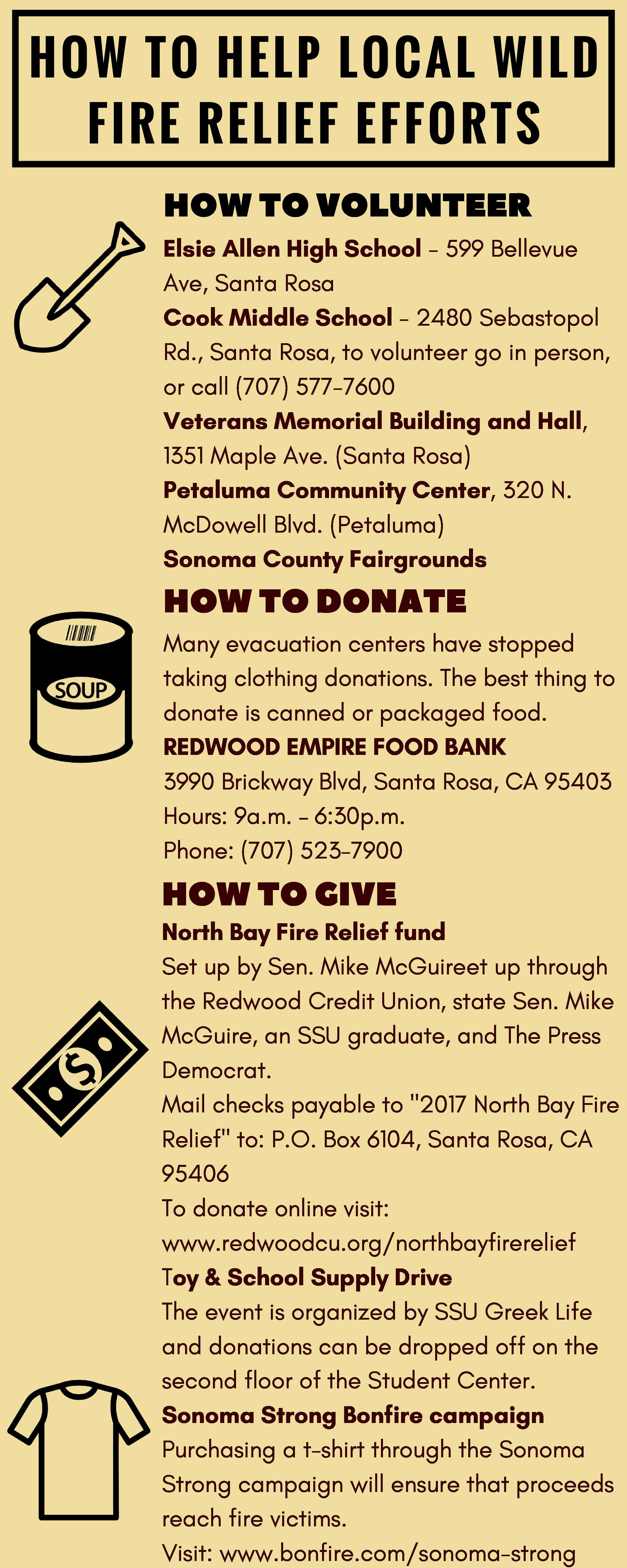With over 180,000 burned acres and countless casualties in the Northern California fires since Oct. 9, many Sonoma State University students may feel overwhelmed in looking for a way to help their community. Students seeking relief services or want to help provide them have several outlets to look into, including the Redwood Empire Food Bank, one of many local organizations accepting and providing food for fire victims. Kevin West, the food bank’s communications coordinator, said nonperishables are still being accepted in the station house at 3990 Brickway Blvd. in Santa Rosa, and that those interested in lending a hand can also make financial donations via the food bank’s website.
“Our operation is in the business of helping hungry people year round,” West said.
Jackson Family Wines donated 30,000 square feet for the food bank to use as a second warehouse for donations. People from all 50 states and some other countries have donated money for fire relief, according to West.
“It’s just amazing,” West said. “As we were halfway through [providing food on Oct. 16], we had already served 200 families.”
In another email, West said the station house will provide free food and beverages this week for anyone in need. These people are not required to provide identification, and are also welcome to visit the food bank’s front parking area Oct. 21 for its monthly Food Plaza distribution service. West said the food bank needs nonperishable food items so it can distribute them to shelters in Sonoma County.
“There are many people that never thought they would need a food bank, but we’re here for them,” West said.
In an Oct. 13 update, the City of Santa Rosa provided a list of organizations that make up the newly established Local Assistance Center. According to the update, the center is “a one-stop-shop with critical services for residents who have been impacted by the fires.”
The center will be open from 9 a.m. to 7 p.m. for at least two weeks at the Santa Rosa Press Democrat building, according to the update. It provides insurance companies, water and utilities, small business and child support services, a FEMA Disaster Recovery Center, DMV representatives to help recover destroyed paperwork, and the American Red Cross. In an Oct. 11 Facebook post that went viral, CSU Student Trustee Emily Hinton described her negative experience working with the American Red Cross at an evacuation center.
“When a new family came in, I presented them with the intake forms and they refused to sign the confidentiality box, saying they didn’t feel safe [doing] so,” Hinton said. “I didn’t understand… until I read [the box], which stated it was a release for American Red Cross to give your information to any governmental agencies, such as FEMA.”
Hinton said she learned that clothes donated to the American Red Cross are not given to fire victims directly, but are sent to Goodwill for them to pick up via a voucher system. She added that she thought the organization sharing victims’ information with the government may not be a good idea, since some undocumented people may require service.
“These people are already vulnerable,” Hinton said. “I doubt most of them are reading the fine print.”
Allana Peerce, Panhellenic President at Sonoma State, used her Facebook account to share a list of wine country organizations in need of fire relief donations. Some shelters, such as the Petaluma Church of Christ and Santa Rosa’s St. Vincent de Paul branch, still require more food. Other areas are looking for more specific items, like Bodega Bay Grange Hall, which has an “urgent need” for firewood, or the DoubleTree hotel in Rohnert Park, which needs baby formula and size 5 diapers.
Jason Gorelick, executive vice president of Associated Students, said many shelters are oversaturated with supplies, but will eventually need expendables such as toiletries, underwear and batteries.
Gorelick said he advised students to focus on financial donations for the time being. To help those at Sonoma State who lost their homes and belongings, he started a t-shirt sale that has raised just under $3000 for staff and students.
Gorelick also recommended various GoFundMe pages for students who lost their homes in the fires, along with the Redwood Credit Union.
“[People working at the Redwood Credit Union] don’t take any cut of the donations,” Gorelick said. “They match the donations, and it’s all local… I think victims need to have some agency with that money.”
Gorelick also commended the Volunteer Center of Sonoma County for serving as a “centralized spot for figuring out which places need what.”
“At the height of the madness, when there were still a massive influx of evacuees coming into shelters… I spoke to the Volunteer Center of Sonoma County, and they’ve done wonderful work doing that coordination that was lacking before that,” Gorelick said.
According to Gorelick, an Oct. 19 open forum will answer students’ questions about what comes next.
“This is the most I’ve ever seen this community coming together,” Gorelick said. “It’s a shame it took a disaster for this to happen, but it’s very heartening.”
To make a financial donation at Redwood Empire Food Bank, go to refb.org.
To donate to Gorelick’s fundraiser, go to bonfire.com/sonoma-strong.
To donate to the Redwood Credit Union’s fire relief fund, go to redwoodcu.org/northbayfirerelief.
For more information on which organizations require donations, check out the Google Doc available on Peerce’s Facebook page.




































